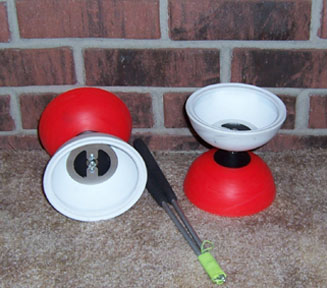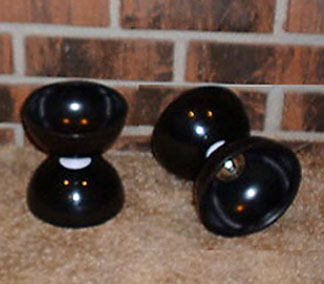
Pictured above are two Mister Babache Finesse (G2) diabolos with 10 gram weights and one way bearing axles. Also shown is a pair of Henry Alumium Sticks with Henry 'GREEN' string. Note: Finesses are sold in solid colors, the above diabolos were diassembled and reassembled into double colors. Mister Babache now sells the Finesse (G3.)
Diabolo's diameter is 5 1/4 inches (135 mm).
Diabolo's height is 5 1/4 - 5 1/2 inches (135 - 140 mm).
Normal weight -247 grams.
With Evolution 3 (6 gram weight set) - 259 grams. LINK
With Evolution 3 (10 gram weight set) - 267 grams. LINK
With both Evolution 3(6&10 weight sets)- 279 grams. LINK
With Evolution 1 (large axle) - add 10 grams. LINK
With Evolution 4 (LED light kit) - add 40 grams. Green Red Yellow Blue Rainbow
With Spintastics' Finesse Bearing Upgrade Kit - add 0 grams. LINK
Mister Babache diabolos were prabably the world-wide favorite especially in the 80's and 90's. The Finesse is their newest product. This model, the G3 'Generaltion Three,' which is an improvement over the initial G1 & G2. The G3 is extremely popular. If ordering a Finesse, be sure to get a G3.
Below is from the Frequently Asked Questions Page.
This diabolo has a 5 1/4 inch (13.5 cm) diameter. It is lighter in weight than other diabolos that size like the Henry Circus. (note: weight accessories can be added) My Finesses run very smooth and are well balanced. The Mister Babache engineers have spent some time with this product. It is a rubber plastic diabolo which doesn't bounce quite as well as the Henry, but it may stay cleaner. It is shorter than other 5 inch diabolos also, that is, it is shorter when sitting on a cup. This may give you a bit more control since it allows you to diabolo a little closer to your body. Who really knows. The Finesse also has a ridge lip around the edge of the cups similar to some the other Mister Babache diabolos. This lip allows for shoe/foot kick-ups which are very possible to start the diabolo. Running two of these is a DREAM! Many Two Diaboloist agree that these run the smoothest of any diabolo available.
They have so far produced three accessory kits for the Fineese in their 'Evolution' series. Evolution 1 is a longer axle they say is good for "finger tricks and dance." I really like this accessory. I don't do a lot of finger tricks or 'dance' (a little something must be lost in the translation), but it allows for Finger nad Hand Grinds. The diabolo still runs very smooth and balanced and the longer axle reduces problems with string tie-ups on release tricks. The main advantage has got to be grinds. Grinding is so sweet with this axle and now even fat sticks can enjoy the true grinding experience.
The Evolution 4 accesssory is a set of weights that add weight to both sides of the diabolo. The sets come as a 6 gram set adding 12 grams and the 10 gram set that adds 20 grams. A very popular set is the 10 gram set.
The other accessory is called Evolution 4. It is a set of lights that fit inside the cups on the axle ends. The set adds a total of 40 grams to weight of the diabolo comparing it to the Henry Circus' normal weight. This becomes an excellent Light Diabolo without too much weight. When lit and spinning the lights produce a nice red ring on each diabolo end. The rubber plastic material of the cups seems to let some light through giving a glowing effect at night when these lights are on. The diabolo runs smooth with the lights added, I'm amazed how it continues to be so well balanced.
Available right now is a One Way Bearing Upgrade Kit from Spintastics. It is the same bearing found in the Spinabolo diabolos with a modified axle.It is......a pair of Babache Harlequins!

Pictured above are 2 two-color Mister Babache Harlequins.
Diabolo's diameter is 5 inches (125 mm).
Diabolo's height is 6 inches (155 mm).
Diabolo's weight 335 grams.
This diabolo has a little bit more weight than most large (5 inch) diabolos. The added weight keeps the diabolo spinning longer, but of course you work a bit harder to gain speed.
Mister Babache diabolos were prabably the world-wide favorite especially in the 80's and 90's. The Harlequin is still very popular.
Pictured above is a solid Blue Mister Babache Jumbo similar to a Harlequin diabolo and a pair of sticks with string. Diabolo's diameter is 5 inches (125 mm). Diabolo's height is 6 inches (155 mm). Diabolo's weight 335 grams. This diabolo has a little bit more weight than most large (5 inch) diabolos. The added weight keeps the diabolo spinning longer, but of course you work a bit harder to gain speed. Mister Babache diabolos were prabably the world-wide favorite especially in the 80's and 90's. The Harlequin is still very popular. Sticks are Fiberglass and 16 inches (40 cm) long. The gray caps on the sticks clue you that this is a Diabolo Tricks set of sticks. String is #18 braided black/white fluorescent nylon 27 inches (69 cm) long. |
 It is.........a pair of Performers!
It is.........a pair of Performers!
Pictured above are two blue Mister Babache Performer diabolos.
Diabolo's diameter is 6 1/4 inches (160 mm).
Diabolo's height is 7 1/4 inches (185mm).
Weight 360 grams.
This diabolo looks great on stage because of its size. It is very well balanced and will indure a lot of drops even from high tosses. Catching bigger diabolos is easier because of the larger throat. The extra weight keeps it spinning longer.
The problems with this diabolo might only be if the performer cannot adjust to the added weight, especially when doing two. The extra size also makes some tricks tight where there may not be enough room for the extra-sized diabolo to fit.

Pictured above are some blue diabolos.
Forth row, left to right: (Performer, Giant);
Third row, left to right: (Renegade, MB Jumbo, II Jumbo);
Second row, left to right: (Henry Jazz. Henry Circus);
First row, left to right: (Henry Kolibri, Early Italian diabolo, MB Piccolino).
Each manufacturer has their own 'blue' .
Pictured above are two UV green Diabglos.
Diabolo's diameter is 4 1/2 inches (11.5 cm).
Diabolo's height is 5 1/2 inches (14 cm).
Diabolo's weight is about 350 grams.
Diabglo is the cool motion-activated lighted version of the diabolo. See Extreme Spins' Diabglo animation. Blue LEDs on both ends flash when you play with the Diabglo. The lights automatically go off after about 10 seconds. Plus its UV green color will glow brightly under blacklight. The cups are made of a thick slightly flexible plastic. Colors are translucent green or translucent clear/silver.
This diabolo is a nice light up diabolo. The lights are not removable and will activate even if the diabolo is tossed about in your prop bag. Each cup has 2 lights and 3 AG-10 batteries, making a battery total of 6 for each Diabglo. To replace batteries the diabglo sticker must be removed or at least the center of it and a small screw comes out.
Great look to audience; Easy for performer to see on high tosses. Runs well balanced. Axles have indented line for better string control. Soft cups for hand tosses and catches. Very durable, especially well protected light circuit board and battery compartment. (Great for night high tosses!)
Bad points: Heavier than most 5 inch diabolos ; Some advertising for this diabolo state "Precision bearings in the center of the cups allow long-lasting spinning action." My diabglos have solid axles, I don't understand what they mean; The softness of the cups could lead to distorted cups if stored incorrectly; The box says that it comes with "spare batteries" and I found none, only those in the diabglo; The box says to "Check out www.diabglo.com for tips, tricks, and hints," but the site is down and has been down; Battery changes require a tiny screwdriver.
IMHO: This is a great additional diabolo. It does tire me out to perform with it for long periods of time, because I am not used to the extra weight, but it is a show stopper even in the daylight to folks that have not seen a light up diabolo. I keep one in my bag when I want to do illumination or night practice outside.
It is.........a Henry Circus!
Pictured above is One Henry Circus Diabolo and a pair of sticks with string. Diabolo's diameter is 5 inches (125 mm). Diabolo's height is 5.5 inches (140 mm). Diabolo's weight is 300 grams. This diabolo is very new (note the lack of string marks). It has been said that the Henry Circus is the 'purest' of all diabolos. The Circus's cups will scuff and show marks but can be cleaned. Its smaller axle and 'throat' design allows for great contol. Sticks are Fiberglass and 16 inches (40 cm) long. The gray caps on the sticks clue you that this is a Diabolo Tricks set of sticks. String is #18 braided orange fluorescent nylon 27 inches (69 cm) long. Length varies depending on diaboloist preference.It is.........a pair of Spinabolos!
|
![[009]D.M.G d!ab0lo CluB](http://2.bp.blogspot.com/_Sw-z3Y707DI/So-H7XqTirI/AAAAAAAAAB4/svp_t9Fgcr4/S660/dmg2.jpg)







